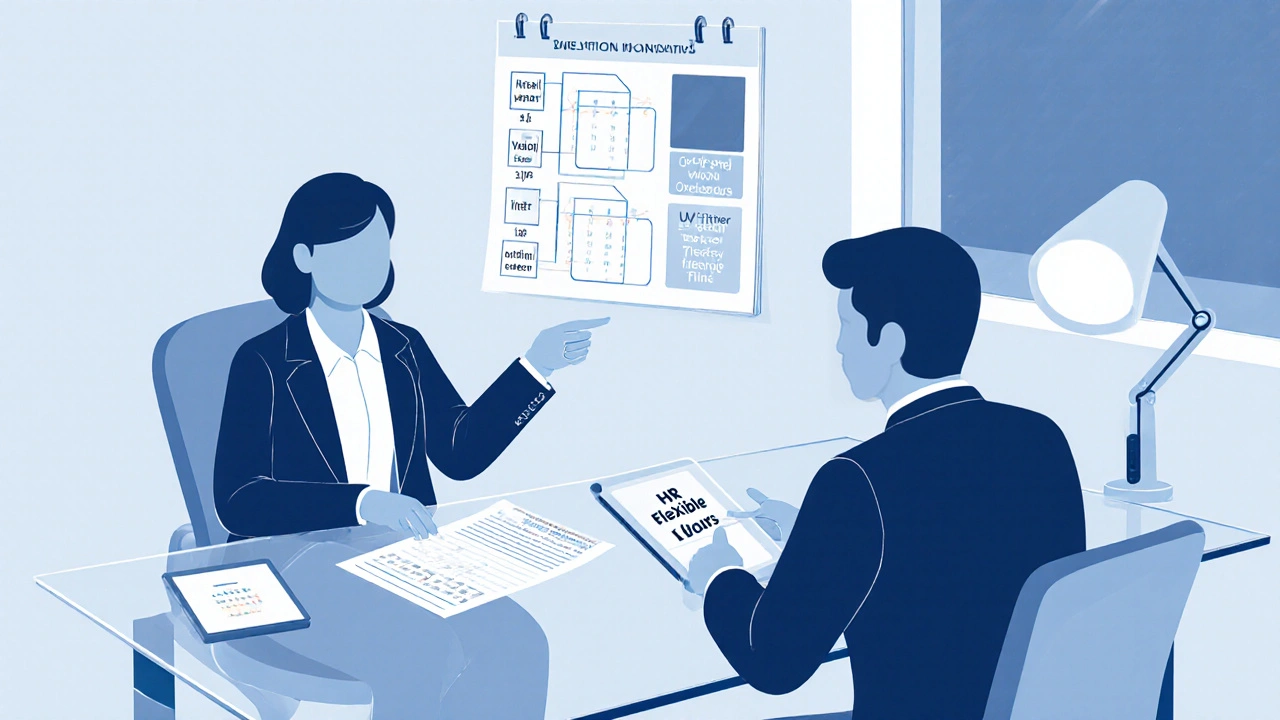Porphyria Type & Workplace Accommodation Guide
Select Your Porphyria Type
Choose your porphyria type to see associated triggers, symptoms, and workplace accommodations.
Tip
Use this information to prepare a medical summary for your employer. It can help explain your condition and the accommodations you might need.
Porphyria is a group of rare metabolic disorders that disrupt the production of heme, the oxygen‑carrying component of blood. When the enzymes that build heme fail, toxic substances build up, causing episodes that can flare up at the worst possible moments - often right in the middle of a workday. If you or a teammate lives with porphyria, figuring out how to stay productive while managing unpredictable symptoms feels like walking a tightrope.
Key Takeaways
- Under the UK Equality Act 2010, porphyria qualifies as a disability, giving you legal protection and a right to reasonable adjustments.
- Identify personal symptom triggers early - fasting, certain medications, and stress are common culprits.
- Prepare a concise medical summary for HR or occupational health, outlining needed adjustments such as flexible hours, safe lighting, or low‑stress tasks.
- Utilise UK resources like NHS specialist porphyria clinics and Porphyria UK for medical advice and workplace support.
- Maintain open communication: frame requests around business needs and how adjustments keep you productive.
Understanding Porphyria Types and Typical Workplace Impact
Porphyria isn’t a single disease; it covers several sub‑types, each with its own symptom pattern. Knowing which type you have helps you anticipate what adjustments will matter most.
| Type | Primary Triggers | Typical Symptoms at Work | Key Accommodation |
|---|---|---|---|
| Acute Intermittent Porphyria (AIP) | Fasting, hormonal changes, certain drugs (e.g., barbiturates) | Severe abdominal pain, confusion, nausea, sudden fatigue | Flexible breaks, access to safe snacks, low‑stress duties |
| Erythropoietic Protoporphyria (EPP) | Sunlight, bright indoor lighting | Photosensitivity, burning skin, eye discomfort | UV‑filtering window films, tinted screens, adjustable lighting |
| Porphyria Cutanea Tarda (PCT) | Alcohol, iron overload, hepatitis C | Blisters on hands, fragile skin, fatigue | Protective gloves, ergonomic tools, reduced exposure to chemicals |
Even within a single type, symptom severity can swing dramatically. That’s why a flexible, individualized plan works best.
Legal Framework: Your Rights Under the Equality Act 2010
In the UK, the Equality Act 2010 protects people with a “substantial” and “long‑term” health condition that has a major impact on daily activities. Porphyria fits that definition for many patients, meaning you are entitled to reasonable adjustments in the workplace.
Reasonable adjustments are changes that remove or lessen a disadvantage caused by a disability. Employers must consider them unless they can prove the change would cause undue hardship - essentially, if the cost or difficulty is excessive.
Typical adjustments for porphyria include:
- Flexible start/end times to accommodate medication schedules or fatigue.
- Provision of low‑carb snacks to prevent fasting‑related attacks.
- Work‑station lighting that can be dimmed or filtered for photosensitivity.
- Remote‑working options during severe flare‑ups.
- Scheduled breaks for hydration or short rest periods.
When you request an adjustment, the employer will likely ask for a medical report. Keep it concise: a one‑page summary from your specialist (often through the NHS porphyria clinic) that lists diagnosis, typical triggers, and recommended accommodations.

Preparing Your Medical Summary
A well‑crafted medical summary can turn a vague request into a clear action plan. Follow this simple structure:
- Diagnosis and Type: State the specific porphyria subtype and date of diagnosis.
- Trigger Overview: List the top three personal triggers (e.g., “fasting longer than 4hours,” “exposure to fluorescent lighting”).
- Typical Workplace Symptoms: Describe how an attack might affect performance (e.g., “sudden abdominal pain leading to a need for a seated break”).
- Recommended Adjustments: Provide concrete suggestions, using the bullet points above as a guide.
- Contact Details: Include the specialist’s name, NHS trust, and a phone number for verification.
Ask your doctor to sign the document and keep a digital copy for easy sharing.
Communicating with Your Employer
Talking about a hidden condition can feel intimidating, but a straightforward conversation builds trust and shows you’re proactive about staying productive. Here’s a script you can adapt:
"I’ve been diagnosed with porphyria employment‑related challenges. When I experience an episode, I can have sudden abdominal pain or extreme fatigue, which can affect my concentration. I’ve prepared a short medical summary that outlines a few adjustments - like flexible breaks and reduced bright lighting - that would help me stay effective. Could we discuss how to implement these without disrupting the team’s workflow?"
Key tips:
- Keep the focus on work outcomes, not on the disease itself.
- Offer a written summary to avoid forgetting details.
- Ask what evidence the HR team needs, then provide it promptly.
If you face resistance, you can reference the Equality Act and remind the employer of their duty to consider reasonable adjustments.
Practical Day‑to‑Day Strategies
Even with accommodations, self‑management remains vital. Incorporate these habits into your routine:
- Meal Planning: Keep a stash of low‑carb, high‑protein snacks (nuts, cheese sticks) at your desk to avoid long fasting periods.
- Hydration: Aim for at least 2liters of water daily; dehydration can trigger attacks.
- Lighting Controls: If you have EPP, use a desk lamp with a warm colour temperature and ask for window films that block UV.
- Stress Buffer: Practice quick breathing exercises during high‑pressure moments - a 2‑minute box breath can lower cortisol.
- Medication Timing: Set phone reminders for any prophylactic drugs (e.g., hemin infusions) so you never miss a dose.
When an attack does strike, let your manager know early. A short message like, “I’m experiencing a severe flare‑up; I’ll need to step away for the next hour,” demonstrates accountability while protecting your health.

Support Networks and Resources
Living with porphyria doesn’t have to be a solo journey. Tap into these UK‑based resources:
- NHS Porphyria Specialist Clinics - Offer diagnosis, genetic counseling, and treatment plans.
- Porphyria UK - Provides patient forums, newsletters, and a list of employers experienced in supporting porphyria.
- Citizens Advice - Can help you understand your legal rights and guide you through grievance procedures.
- Acas (Advisory, Conciliation and Arbitration Service) - Offers mediation if employer‑employee disputes arise over adjustments.
Connecting with others who share your condition gives you practical tips, from which snack brands stay low‑carb to the best screen‑filter apps for photosensitivity.
When Adjustments Aren’t Enough: Benefits and Legal Recourse
If your employer refuses to make reasonable adjustments, you have several pathways:
- Internal Grievance: Submit a formal complaint through your HR department, outlining the specific adjustment denied and citing the Equality Act.
- Employment Tribunal: If the grievance fails, you can bring a claim to an employment tribunal within three months of the decision.
- Disability Benefits: Apply for Personal Independence Payment (PIP) if daily living activities are substantially limited. The benefit can supplement income while you negotiate workplace solutions.
Document every conversation - dates, who you spoke with, and what was discussed. This record becomes crucial evidence should legal action be needed.
Quick Checklist Before a New Job Starts
- Obtain a recent medical summary from your porphyria specialist.
- Review the job description for potential triggers (e.g., travel, shift work).
- Prepare a list of reasonable adjustments tailored to the role.
- Contact the HR department during the onboarding phase to discuss accommodations.
- Set up an emergency plan - who to call at work if an acute attack occurs.
Having this checklist handy streamlines the onboarding conversation and shows you’re organized.
Frequently Asked Questions
Does porphyria count as a disability under UK law?
Yes. The Equality Act 2010 defines a disability as a physical or mental impairment that has a substantial and long‑term effect on a person's ability to carry out normal day‑to‑day activities. Most porphyria types meet this definition because attacks can significantly limit work performance over many years.
What are "reasonable adjustments" for someone with acute intermittent porphyria?
Common adjustments include flexible work hours, access to low‑carb snacks, the ability to take short rest breaks, and a private space for medication administration. Employers should also avoid assigning tasks that require prolonged fasting or high‑stress environments without mitigation.
Can I request remote work if my porphyria attacks are frequent?
Yes. Remote work is a recognized reasonable adjustment when it helps the employee manage health episodes. Provide evidence of how working from home reduces triggers (e.g., control over lighting, immediate access to medication) to strengthen your request.
What should I do if my employer refuses a necessary adjustment?
Start with an internal grievance, documenting all communications. If unresolved, you can file a claim with an employment tribunal within three months. Simultaneously, seek advice from Citizens Advice or Acas to explore mediation options.
Are there specific benefits for people with porphyria?
You may be eligible for Personal Independence Payment (PIP) if daily living activities are substantially limited. Additionally, some employers offer health‑related absenteeism schemes that can cover lost wages during severe attacks.
